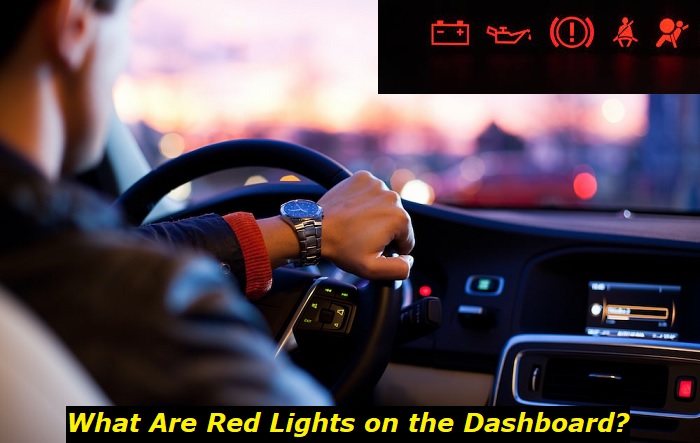Modern vehicles are equipped with dozens of self-diagnostics modules that are aimed to locate issues in your car at all times they happen and warn you about these issues. For this, manufacturers use all different kinds of sensors that send their readings to the ECU - electronic control module. Then, if the ECU registers some decline in the readings, it will light up one of the warning lights on the dash and maybe show you a message clarifying the meaning of the error.
In short, a red warning light on a car's dashboard always means some serious problem. But it doesn't mean that at all times when you see the red light on your dash, you should immediately stop and avoid driving further.

In this article, I will tell you more about the difference between red and yellow warning lights (also called orange or amber) so that you could avoid spending hundreds of dollars on tow trucks.
Let's get started!
What are the red warning lights?
The entire surface of your dashboard is covered with warning lights that can go on the dash once something goes wrong. In modern screen-dashes, the warning lights become even more sophisticated and can take more forms and types. This means that in the future, recognizing and understanding these warnings will only become more complicated.
So, car manufacturers agreed to follow this simple standard feature: yellow or amber warning lights are just informative and don't tell you about any serious damages to your vehicle while red lights are urgent and require immediate reaction.
Here are some key features of the red warning lights:
- they are usually accompanied by an error message that may not last long, then only the light may stay on;
- each light tells you about a certain module or unit that may malfunction;
- the light may also go off if the problem is solved;
- sometimes, red lights may signal about a problem that requires your attention but still allows you to drive further;
- there aren't many red lights on the dash of your car, so read the driver's manual and get acquainted with them;
- in most cases, if the red light is on, it won't disappear without your help, so it's important to understand what's going on.
Unfortunately, the internet is full of misinformation and it tells you that each time you see the red warning light on the dashboard, you have to stop, call a tow truck and invest in repairing your vehicle. This is not always so. While some issues with red light really require immediate attention, the majority of cases should be treated reasonably and without calling a tow truck.
I will make some examples of the most common red warning lights in your car and explain what can cause them.
1. Battery light
This light is always red and it tells you about the problems with your 12V battery, alternator, charging process, voltage in the system, lost connections, etc. In most cases, this red warning light will go on the dash when the battery isn't charging or has to kick in sometimes to assist the alternator. So, it may signal about problems with your alternator, most of the time.
But it doesn't mean that you have to stop immediately. You can continue driving for about 3 hours before your battery is dead. And I believe this time is completely enough to drive to one of the trusted repair shops.
2. Engine oil pressure light
This red light shows you the old-fashioned lubricator with a drop of oil falling from its nozzle. It's also always red in color. This is a more serious warning light that may tell you about low oil levels, problems with the oil pump, or issues with the oil pressure sensor. Whatever happens, you should stop the vehicle immediately because engine damage is quite possible.
Check the oil level and add some oil if needed. If the level is not the problem that triggered the light, just call for help. Driving your car in this condition is not safe for the engine.
3. Brake system problem light
The brake system problem red light is the exclamation mark in the circle and then in additional brackets. This light may go on because of several reasons:
- your handbrake is activated;
- low brake fluid level;
- worn-out brake pads;
- handbrake switch failure;
- other issues with brakes.
If you see this light, you should check the handbrake and then check the brake fluid level in the reservoir. If everything is OK but the light is still on, you can slowly drive on the right side of the road with your emergency lights on. But if you feel that the brakes are affected, don't drive - this may be dangerous for you and for other people on the road.
4. Coolant temperature warning light
This light represents the thermometer immersed in the wave water. It means that there is a problem with the temperature of the engine coolant in your car. It essentially tells you that the coolant temperature is too high and the car needs some time to cool down.
This light doesn't tell you that you should stop and call a tow truck. It only tells you that the coolant is too high and it's a good idea to stop and turn off the engine to let it cool down. Once the coolant is cold again, you can start your engine and drive.
But driving with this warning light on the dash is not recommended. Modern engines are very sensitive to any kind of overheating and may just die because of this issue.
You may keep driving after the coolant is cooled a little. But when you arrive at your destination, plan a visit to a good repair shop to check what's wrong with the car.
5. Safety belt warning light
This light shows you a person with a fastened seatbelt in red color. It means one of two possible things:
- your seatbelt is not fastened and the car warns you that it's not legal to drive like that;
- your seatbelt sensor located in the belt lock malfunctions.
You can still drive with this red warning light on the dash but be ready to hear some chimes or see error messages warning you that driving without a fastened seatbelt is not safe.
6. Steering system malfunction
This type of warning light may be red or yellow. If it's red, it tells you about a serious problem with the steering assist. In most cases, this light will go on when there is a problem with the electric steering assist. These types of assists have several sensors that can register problems.
Also, this red light may mean that the fluid level in the hydraulic steering assist is low or the pump is malfunctioning and can't create the needed pressure.
In most cases, you can continue driving carefully if the steering assist still helps you turn the steering wheel. If you feel that the wheel became too hard to turn, better stop in a safe place and call for help.
7. Airbag warning lights
The airbag warning light shows you a person with a fastened seatbelt and a deployed airbag that is shown as a red circle in front of the person. This warning light means that there is a problem with one of the airbags or with the SRS module that controls these airbags. Also, it may indicate issues with wiring.
In most cases, you will see this warning light after accidents when the airbag was deployed. Even if you install the new airbag, the SRS system will show this warning light and will need a complete reset or replacement.
So, you can usually drive when this red warning light is on the dashboard - the vehicle won't change its behavior and won't disturb your driving.
8. Transmission warning light
This red light shows you the gear with the exclamation mark inside. It means that one of the sensors in your transmission sends the wrong readings. In modern DCT transmissions or CVT units, this most likely means that you are about to spend several thousand dollars on repair. But sometimes, it may just mean that some sensor is problematic or the fluid level in the transmission is low.
You may try turning off the engine for 10-15 minutes and letting the transmission cool down. Maybe, the sensor is just showing you the problem with the transmission temperature. If this doesn't help, go to the repair shop and check the transmission.
How can I learn more about the problem with the red light on the dash?
Every warning light is triggered after the ECU gets bad readings from one of the sensors - this is just how it works. The warning light is triggered after the ECU forms one or several error codes according to the readings of the sensors it gets.
So, the most natural way to learn what's going on with your car is to connect a scanner to the OBD 2 port and just read the codes. This will indicate which exact sensor caused the light to go on the dash. Usually, this helps you identify the actual problem.
Also, in some cases, the red warning lights will just tell you that some fluid is low and you need to top up it before you keep on driving.
If the red light indicates a more serious problem with safety, never keep driving till you understand what's going on with the car.
About the authors
The CarAraC research team is composed of seasoned auto mechanics and automotive industry professionals, including individuals with advanced degrees and certifications in their field. Our team members boast prestigious credentials, reflecting their extensive knowledge and skills. These qualifications include: IMI: Institute of the Motor Industry, ASE-Certified Master Automobile Technicians; Coventry University, Graduate of MA in Automotive Journalism; Politecnico di Torino, Italy, MS Automotive Engineering; Ss. Cyril and Methodius University in Skopje, Mechanical University in Skopje; TOC Automotive College; DHA Suffa University, Department of Mechanical Engineering






Add comment